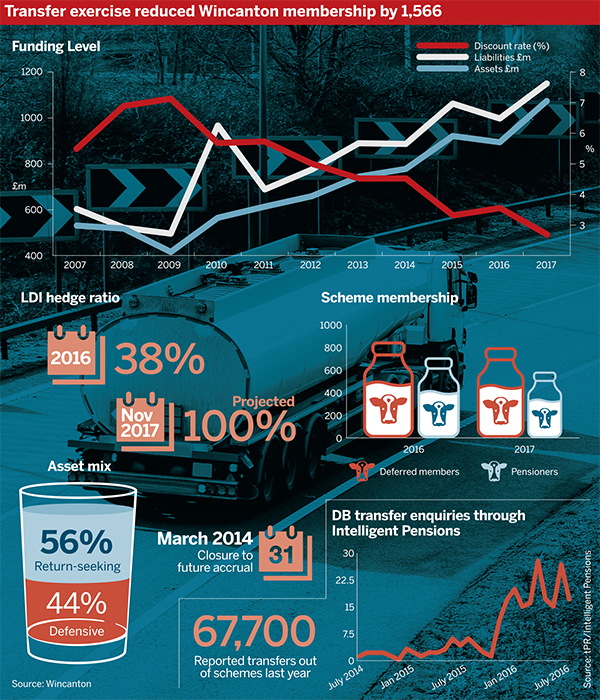The Wincanton Pension Scheme has embarked on an enhanced transfer value exercise in an attempt to further cap its obligations, after trivial commutations wiped £3.8m from its liabilities.
Some 80,000 members are estimated by the Pensions Regulator to have left defined benefit pension schemes in the year to March 31 – of about 11m members in the entire DB universe – as transfer offers reached new highs.
When the Wincanton pension scheme reminded its members of their right to transfer, 1,566 people with small pots left the £1.08bn scheme, helping the deficit shrink during a year when employer contributions battled against a headwind of falling yields.
It’s an area where the facts of each scheme are very important as to how appropriate the various liability management techniques might be
Mark Ashworth, Law Debenture Pension Trustees
Shrinking liabilities expected
The scheme saw its membership drop to 13,913 deferreds and pensioners during the year from previously 15,650, largely due to the transfer exercises undertaken by the trustees. The fund was closed to future accrual in March 2014.
“The trustee has... written to members with small pension pots to remind them of the option under normal scheme rules to exchange their benefits for a one-off cash sum,” Wincanton’s annual results explained.

Noting the benefit to the scheme’s balance sheet, the report anticipated further benefits from the enhanced transfer value exercise, albeit with a cost for the group of almost £1m, related to the provision of financial advice for members.
“This exercise will conclude in the first half of the year ended March 31 2018, together with an associated cash outflow to fund the enhanced transfer values and an expected reduction in pension liabilities,” it added.
More transfers needed?
JLT Benefit Solutions director Rob Dales said liability management exercises are somewhat underused by trustee boards, likely because of preconceptions about retirement planning.
“A lot of trustees tell me that their scheme-generated income in retirement is right for their members,” he said, but added: “How do you know?”
Labelling such exercises as derisking can lead schemes to believe that someone must be losing out, said Dales, but noted this was often not the case. “I always talk about member options – make members aware of all the options they’ve got now.”
However, Mark Ashworth, chair of Law Debenture Pension Trustees, said he doubted that many trustees were unaware of the benefits of enhanced transfer value exercises and trivial commutation, and urged caution.
More pensioners to be offered Pie at Metal Box
The Metal Box Pension Scheme is planning to offer a pension increase exchange to more pensioner members this year, having offered one to some members in 2015.
“One has to be careful... that the take-up is going to be sufficient to justify what can be substantial costs, and it’s an area where the facts of each scheme are very important as to how appropriate the various liability management techniques might be,” he said.
He stressed that accurate and fair communication of options to members was essential, alongside acceptance that enhanced transfer value exercises would not solve DB funding problems.
Shedding rates exposure
To further secure its improved funding level, the Wincanton scheme also extended its hedging programme, aiming to eliminate its exposure to interest rates and inflation by November.
Rate movements did affect the scheme during the year to the end of March, adding £201.1m to liabilities despite a current hedge ratio of 89 per cent for inflation and 78 per cent for interest rates.
However, employer contributions of £14.8m from its logistics provider sponsor, coupled with investment returns of £196.5m, reduced the overall IAS 19 deficit to £76.2m from £103.9m.
Schemes are increasingly being encouraged to view a 100 per cent hedge as a neutral position, despite relatively few schemes actually achieving it.
Ashworth warned that trustees approaching full hedging should be wary of going too far, particularly in an environment where rates could rise more than market expectations. “You need to have sufficient assets available as collateral if rates move [up] against you,” he said.














